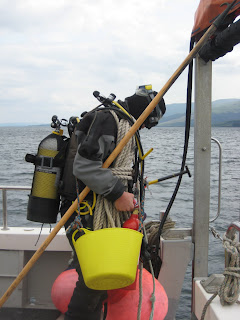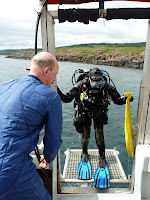July 1st, 2010
Sadly, it’s our last full day in Lochaline. The field school has flown by. We’ve been working on site for about two weeks and have accomplished a great deal in such a short span of time. What made the project so pleasant was the exceptional weather we’ve enjoyed this past fortnight. This morning we got out of bed ready to finish the few tasks that still needed to be completed and were greeted with true Scottish weather. The fog and rain meant that we would all be getting wet in the interest of site preservation as we still needed to place sandbags over our excavation trenches.
Mary assembled us for our morning briefing, gave us our marching orders and we were off. Rich and I hit the beach to load the sandbags. “Scuba” Steve and his scuba team of Michelle, Lesley, Sergey and Dan Pollard headed off to borrow Colin’s boat which would serve as today’s dive platform.
In this flurry of activity Mary joined Rich and me on the beach filling sandbags. We loaded up the van with our wet sandy bags and set off for the pier where the scuba team was waiting. “Scuba” Steve went to fetch our main squiggy boat that would transport the sandbags. While waiting for Steve at the pier we had time for a quick photo.
 Once everything was loaded on the two squiggy boats they set off for the site to carefully place the sandbags over the excavated parts of the wreck. “Scuba” Steve and his two scuba angels Michelle and Lesley took the lead in Squiggy 1 while towing Sergey and Dan Pollard in Squiggy 2. Dan, being a man of the sea, knew his boat could handle the choppy waters and insisted he could make it to the site unaided by Squiggy 1. I can still hear Dan now shouting “but I’ve got a 2 and a half horse power engine. This thing is ready to fly”.
Once everything was loaded on the two squiggy boats they set off for the site to carefully place the sandbags over the excavated parts of the wreck. “Scuba” Steve and his two scuba angels Michelle and Lesley took the lead in Squiggy 1 while towing Sergey and Dan Pollard in Squiggy 2. Dan, being a man of the sea, knew his boat could handle the choppy waters and insisted he could make it to the site unaided by Squiggy 1. I can still hear Dan now shouting “but I’ve got a 2 and a half horse power engine. This thing is ready to fly”. Here is where Mary, Rich and myself leave the valiant scuba team to carry on while we go back to the house to start the process of organizing and archiving. Like a well-oiled machine, both teams took care of their assignments and the morning was a success. We all met up at the place we’ve called home for the last two weeks and finished up the odds and ends for the project.
We’ve got a big feast planned for tonight to celebrate the hard work we’ve put in and to reinforce the friendships we’ve made. We all came in with different strengths and interests but we will all leave as better nautical archaeologists thanks to the efforts of Mary Harvey, Colin and Paula Martin, Steve Liscoe, Sara Hasan, and especially Mark and Annabel Lawrence of Lochaline Dive Centre. I’ve thoroughly enjoyed myself and am glad I got the chance to get to know everyone who participated in the Sound of Mull Field School 2010. Same time next year Mary?
























